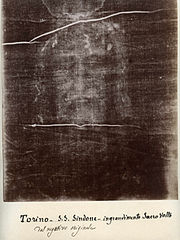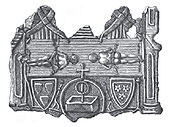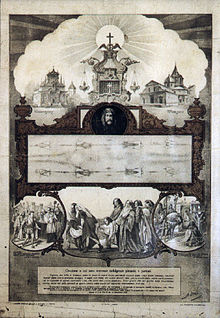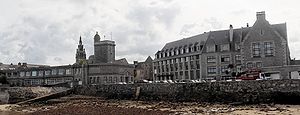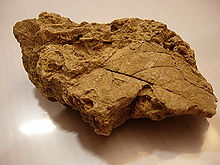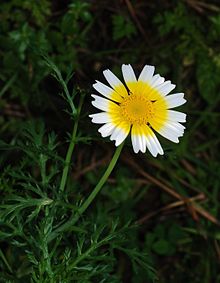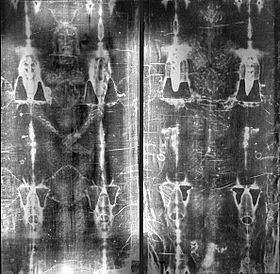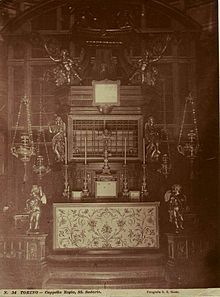
Shroud of Turin
Background Information
This selection is made for schools by a children's charity read more. Before you decide about sponsoring a child, why not learn about different sponsorship charities first?

The Shroud of Turin or Turin Shroud (Italian: Sindone di Torino, Sacra Sindone) is a linen cloth bearing the image of a man who appears to have suffered physical trauma in a manner consistent with crucifixion. It is kept in the royal chapel of the Cathedral of Saint John the Baptist in Turin, northern Italy. The image on the shroud is commonly associated with Jesus Christ, his crucifixion and burial. It is much clearer in black-and-white negative than in its natural sepia colour. The negative image was first observed in 1898, on the reverse photographic plate of amateur photographer Secondo Pia, who was allowed to photograph it while it was being exhibited in the Turin Cathedral.
The origins of the shroud and its image are the subject of intense debate among scientists, theologians, historians and researchers. Scientific and popular publications have presented diverse arguments for both authenticity and possible methods of forgery. A variety of scientific theories regarding the shroud have since been proposed, based on disciplines ranging from chemistry to biology and medical forensics to optical image analysis. The Catholic Church has neither formally endorsed nor rejected the shroud, but in 1958 Pope Pius XII approved of the image in association with the Roman Catholic devotion to the Holy Face of Jesus.
In 1978, a detailed examination was carried out by a team of American scientists called STURP. STURP found no reliable evidence of forgery, and called the question of how the image was formed "a mystery". In 1988 a radiocarbon dating test was performed on small samples of the shroud. The laboratories at the University of Oxford, the University of Arizona, and the Swiss Federal Institute of Technology, concurred that the samples they tested dated from the Middle Ages, between 1260 and 1390. In 2008 a former STURP member stated that sample was representative of the whole shroud.
Since 2005, at least four articles have been published in scholarly sources stating that the samples used for the dating test may not have been representative of the whole Shroud. According to former Nature editor Philip Ball, "it's fair to say that, despite the seemingly definitive tests in 1988, the status of the Shroud of Turin is murkier than ever. Not least, the nature of the image and how it was fixed on the cloth remain deeply puzzling". The shroud continues to remain one of the most studied and controversial artifacts in human history.
Description
The shroud is rectangular, measuring approximately 4.4 × 1.1 m (14.3 × 3.7 ft). The cloth is woven in a three-to-one herringbone twill composed of flax fibrils. Its most distinctive characteristic is the faint, brownish image of a front and back view of a naked man with his hands folded across his groin. The two views are aligned along the midplane of the body and point in opposite directions. The front and back views of the head nearly meet at the middle of the cloth.
Reddish brown stains that have been said to include whole blood are found on the cloth, showing various wounds that, according to proponents, correlate with the yellowish image, the pathophysiology of crucifixion, and the Biblical description of the death of Jesus:
Markings on the cloth include:
- one wrist bears a large, round wound, claimed to be from piercing (the second wrist is hidden by the folding of the hands)
- upward gouge in the side penetrating into the thoracic cavity. Proponents claim this was a post-mortem event and there are separate components of red blood cells and serum draining from the lesion
- small punctures around the forehead and scalp
- scores of linear wounds on the torso and legs. Proponents claim that the wounds are consistent with the distinctive dumbbell wounds of a Roman flagrum.
- swelling of the face from severe beatings
- streams of blood down both arms. Proponents claim that the blood drippings from the main flow occurred in response to gravity at an angle that would occur during crucifixion
- large puncture wounds in the feet as if pierced by a single spike
The details of the image on the shroud are not easily distinguishable by the naked eye, and were first observed after the advent of photography. In May 1898 amateur Italian photographer Secondo Pia was allowed to photograph the shroud and he took the first photograph of the shroud on the evening of May 28, 1898. Pia was startled by the visible image of the negative plate in his darkroom. Negatives of the image give the appearance of a positive image, which implies that the shroud image is itself effectively a negative of some kind. Pia was at first accused of doctoring his photographs, but was vindicated in 1931 when a professional photographer, Giuseppe Enrie, also photographed the shroud and his findings supported Pia's. In 1978 Miller and Pellicori took ultraviolet photographs of the shroud.
The image of the "Man of the Shroud" has a beard, moustache, and shoulder-length hair parted in the middle. He is muscular and tall (various experts have measured him as from 1.70 m, or roughly 5 ft 7 in, to 1.88 m, or 6 ft 2 in). The shroud was damaged in a fire in 1532 in the chapel in Chambery, France. There are some burn holes and scorched areas down both sides of the linen, caused by contact with molten silver during the fire that burned through it in places while it was folded. Fourteen large triangular patches and eight smaller ones were sewn onto the cloth by Poor Clare nuns to repair the damage.
History
The historical records for the shroud can be separated into two time periods: before 1390 and from 1390 to the present. The period until 1390 is subject to debate and controversy among historians. Author Ian Wilson has proposed that the Shroud was the Image of Edessa, but scholars such as Averil Cameron have stated that the history of the Image of Edessa represents "very murky territory", can not be traced back as a miraculous image and it may not have even been a cloth.
Prior to the 14th century there are some congruent references such as the Pray Codex. It is often mentioned that the first certain historical record dates from 1353 or 1357. However the presence of the Turin Shroud in Lirey, France, is only undoubtedly attested in 1390 when Bishop Pierre d'Arcis wrote a memorandum to Antipope Clement VII, stating that the shroud was a forgery and that the artist had confessed. The history from the 15th century to the present is well understood. In 1453 Margaret de Charny deeded the Shroud to the House of Savoy. In 1578 the shroud was transferred in Turin. As of the 17th century the shroud has been displayed (e.g. in the chapel built for that purpose by Guarino Guarini) and in the 19th century it was first photographed during a public exhibition.
There are no definite historical records concerning the shroud prior to the 14th century. Although there are numerous reports of Jesus' burial shroud, or an image of his head, of unknown origin, being venerated in various locations before the 14th century, there is no historical evidence that these refer to the shroud currently at Turin Cathedral. A burial cloth, which some historians maintain was the Shroud, was owned by the Byzantine emperors but disappeared during the Sack of Constantinople in 1204.
Historical records seem to indicate that a shroud bearing an image of a crucified man existed in the small town of Lirey around the years 1353 to 1357 in the possession of a French Knight, Geoffroi de Charny, who died at the Battle of Poitiers in 1356. However the correspondence of this shroud with the shroud in Turin, and its very origin has been debated by scholars and lay authors, with claims of forgery attributed to artists born a century apart. Some contend that the Lirey shroud was the work of a confessed forger and murderer.
The history of the shroud from the 15th century is well recorded. In 1532, the shroud suffered damage from a fire in a chapel of Chambéry, capital of the Savoy region, where it was stored. A drop of molten silver from the reliquary produced a symmetrically placed mark through the layers of the folded cloth. Poor Clare Nuns attempted to repair this damage with patches. In 1578 Emmanuel Philibert, Duke of Savoy ordered the cloth to be brought from Chambéry to Turin and it has remained at Turin ever since.
Repairs were made to the shroud in 1694 by Sebastian Valfrè to improve the repairs of the Poor Clare nuns. Further repairs were made in 1868 by Clotilde of Savoy. The shroud remained the property of the House of Savoy until 1983, when it was given to the Holy See, the rule of the House of Savoy having ended in 1946.
A fire, possibly caused by arson, threatened the shroud on 11 April 1997. In 2002, the Holy See had the shroud restored. The cloth backing and thirty patches were removed, making it possible to photograph and scan the reverse side of the cloth, which had been hidden from view. A ghostly part-image of the body was found on the back of the shroud in 2004. The most recent public exhibition of the Shroud was in 2010.
Religious perspective
Religious beliefs about the burial cloths of Jesus have existed for centuries. The Gospels of Matthew[ 27:59–60], Mark[ 15:46] and Luke[ 23:53] state that Joseph of Arimathea wrapped the body of Jesus in a piece of linen cloth and placed it in a new tomb. The Gospel of John[ 19:38–40] refers to strips of linen used by Joseph of Arimathea and John[ 20:6–7] states that Apostle Peter found multiple pieces of burial cloth after the tomb was found open, strips of linen cloth for the body and a separate cloth for the head.
Although pieces of burial cloths of Jesus are claimed by at least four churches in France and three in Italy, none has gathered as much religious following as the Shroud of Turin. The religious beliefs and practices associated with the shroud predate historical and scientific discussions and have continued in the 21st century, although the Catholic Church has never claimed its authenticity. An example is the Holy Face Medal bearing the image from the shroud, worn by some Catholics.
John Calvin on the shroud
In 1543 John Calvin, in his Treatise on Relics, wrote of the shroud, which was then at Nice (it was moved to Turin in 1578), "How is it possible that those sacred historians, who carefully related all the miracles that took place at Christ's death, should have omitted to mention one so remarkable as the likeness of the body of our Lord remaining on its wrapping sheet?" He also noted that, according to St. John, there was one sheet covering Jesus's body, and a separate cloth covering his head. He then stated that "either St. John is a liar," or else anyone who promotes such a shroud is "convicted of falsehood and deceit". However, the Sudarium of Oviedo is claimed to be another cloth wrapped around the head of Jesus Christ after he died. This cloth may have also been placed in the tomb due to particular emphasis on the sanctity and burial of blood in Jewish tradition.
Devotions
Although the shroud image is currently associated with Catholic devotions to the Holy Face of Jesus, the devotions themselves predate Secondo Pia's 1898 photograph. Such devotions had been started in 1844 by the Carmelite nun Marie of St Peter (based on "pre-crucifixion" images associated with the Veil of Veronica) and promoted by Leo Dupont, also called the Apostle of the Holy Face. In 1851 Leo Dupont formed the "Archconfraternity of the Holy Face" in Tours, France, well before Secondo Pia took the photograph of the shroud.
Miraculous image
The religious concept of "miraculous image" has been applied to the Shroud of Turin, as it has been applied to other religious artifacts such as the image of the Virgin Mary on the cloak in the Basilica of Our Lady of Guadalupe on Tepeyac hill in Mexico.
Without debating scientific issues, some believers state as a matter of faith that empirical analysis and scientific methods will perhaps never advance to a level sufficient for understanding the divine methods used for image formation on the shroud, since the body around whom the shroud was wrapped was not merely human, but divine, and believe that the image on the shroud was miraculously produced at the moment of Resurrection.
While most miraculous theories do not attempt to provide explanations, John Jackson (a member of STURP) has proposed that the image was formed by radiation methods beyond the understanding of current science, in particular via the "collapsing cloth" onto a body that was radiating energy at the moment of resurrection. However, STURP member Alan Adler has stated that Jackson's theory is not generally accepted as scientific, given that it runs counter to the known laws of physics.
In 1989 physicist Thomas Phillips, theorized that the Shroud image was formed by neutron radiation due to a miraculous bodily resurrection.
Vatican position
Antipope Clement VII refrained from expressing his opinion on the shroud; however, subsequent popes from Julius II on took its authenticity for granted.
The Vatican newspaper Osservatore Romano covered the story of Secondo Pia's photograph of May 28, 1898 in its June 15, 1898 edition, but it did so with no comment and thereafter Church officials generally refrained from officially commenting on the photograph for almost half a century.
The first official association between the image on the Shroud and the Catholic Church was made in 1940 based on the formal request by Sister Maria Pierina De Micheli to the curia in Milan to obtain authorization to produce a medal with the image. The authorization was granted and the first medal with the image was offered to Pope Pius XII who approved the medal. The image was then used on what became known as the Holy Face Medal worn by many Catholics, initially as a means of protection during World War II. In 1958 Pope Pius XII approved of the image in association with the devotion to the Holy Face of Jesus, and declared its feast to be celebrated every year the day before Ash Wednesday. Following the approval by Pope Pius XII, Catholic devotions to the Holy Face of Jesus have been almost exclusively associated with the image on the shroud.
In 1983 the Shroud was given to the Holy See by the House of Savoy. However, as with all relics of this kind, the Roman Catholic Church made no pronouncements claiming whether it is Jesus' burial shroud, or if it is a forgery. As with other approved Catholic devotions, the matter has been left to the personal decision of the faithful, as long as the Church does not issue a future notification to the contrary. In the Church's view, whether the cloth is authentic or not has no bearing whatsoever on the validity of what Jesus taught nor on the saving power of his death and resurrection.
Pope John Paul II stated in 1998 that: "Since it is not a matter of faith, the Church has no specific competence to pronounce on these questions. She entrusts to scientists the task of continuing to investigate, so that satisfactory answers may be found to the questions connected with this Sheet". Pope John Paul II showed himself to be deeply moved by the image of the Shroud and arranged for public showings in 1998 and 2000. In his address at the Turin Cathedral on Sunday May 24, 1998 (the occasion of the 100th year of Secondo Pia's May 28, 1898 photograph), he said: "The Shroud is an image of God's love as well as of human sin [...] The imprint left by the tortured body of the Crucified One, which attests to the tremendous human capacity for causing pain and death to one's fellow man, stands as an icon of the suffering of the innocent in every age."
In 2000, Cardinal Ratzinger, later to be known as Pope Benedict XVI, wrote that the Shroud of Turin is "a truly mysterious image, which no human artistry was capable of producing. In some inexplicable way, it appeared imprinted upon cloth and claimed to show the true face of Christ, the crucified and risen Lord." In June 2008, three years after he assumed the papacy, Pope Benedict announced that the Shroud would be publicly displayed in the spring of 2010, and stated that he would like to go to Turin to see it along with other pilgrims. During his visit in Turin on Sunday May 2, 2010, Benedict described the Shroud of Turin as an "extraordinary Icon", the "Icon of Holy Saturday [...] corresponding in every way to what the Gospels tell us of Jesus", "an Icon written in blood, the blood of a man who was scourged, crowned with thorns, crucified and whose right side was pierced". The pope said also that in the Turin Shroud "we see, as in a mirror, our suffering in the suffering of Christ". On May 30, 2010, Benedict XVI beatified Sister Maria Pierina De Micheli who coined the Holy Face Medal, based on Secondo Pia's photograph of the Shroud.
Scientific perspective
The term sindonology (from the Greek σινδών—sindon, the word used in the Gospel of Mark[ 15:46] to describe the type of the burial cloth of Jesus) is used to refer to the formal study of the Shroud.
Secondo Pia's 1898 photographs of the shroud allowed the scientific community to begin to study it. A variety of scientific theories regarding the shroud have since been proposed, based on disciplines ranging from chemistry to biology and medical forensics to optical image analysis. The scientific approaches to the study of the Shroud fall into three groups: material analysis (both chemical and historical), biology and medical forensics and image analysis.
Early studies
The initial steps towards the scientific study of the shroud were taken soon after the first set of black and white photographs became available early in the 20th century. In 1902 Yves Delage, a French professor of comparative anatomy published the first study on the subject. Delage declared the image anatomically flawless and argued that the features of rigor mortis, wounds, and blood flows were evidence that the image was formed by direct or indirect contact with a corpse. William Meacham mentions several other medical studies between 1936 and 1981 that agree with Delage. However, these were all indirect studies without access to the shroud itself.
The first direct examination of the shroud by a scientific team was undertaken in 1969–1973 in order to advise on preservation of the shroud and determine specific testing methods. This led to the appointment of an 11-member Turin Commission to advise on the preservation of the relic and on specific testing. Five of the commission members were scientists, and preliminary studies of samples of the fabric were conducted in 1973.
In 1976 physicist John P. Jackson, thermodynamicist Eric Jumper and photographer William Mottern used image analysis technologies developed in aerospace science for analyzing the images of the Shroud. In 1977 these three scientists and over thirty others formed the Shroud of Turin Research Project. In 1978 this group, often called STURP, was given direct access to the Shroud.
Material chemical analysis
Radiocarbon dating
After years of discussion, the Holy See permitted radiocarbon dating on portions of a swatch taken from a corner of the shroud. Independent tests in 1988 at the University of Oxford, the University of Arizona, and the Swiss Federal Institute of Technology concluded with 95% confidence that the shroud material dated to 1260–1390 AD. This 13th to 14th century dating is much too recent for the shroud to have been associated with Jesus of Nazareth. The dating does however match the first appearance of the shroud in church history. This dating is also slightly more recent than that estimated by art historian W.S.A. Dale, who postulated on artistic grounds that the shroud is an 11th century icon made for use in worship services.
Although the quality of the radiocarbon testing itself is unquestioned, criticisms have been raised regarding the choice of the sample taken for testing, with suggestions that the sample may represent a medieval "invisible" repair fragment rather than the image-bearing cloth. Additionally, the shroud was damaged in fire in 1532 and the carbon dating results may be significantly skewed by more than 1,000 years.
The official report of the dating process, written by the people who performed the sampling, states that the sample "came from a single site on the main body of the shroud away from any patches or charred areas." In 2008 former STURP member John Jackson rejected the possibility that the C14 sample may have been conducted on a medieval repair fragment, on the basis that the radiographs and transmitted light images taken by STURP in 1978 clearly show that the natural colour bandings present throughout the linen of the shroud propagate in an uninterrupted fashion through the region that would later provide the sample for radiocarbon dating. Jackson stated that this could not have been possible if the sampled area was a later addition.
Since the C14 dating at least four articles have been published in scholarly sources contending that the samples used for the dating test may not have been representative of the whole shroud. These included a 2005 article by Raymond Rogers, who conducted chemical analysis for the Shroud of Turin Research Project and who was involved in work with the Shroud since the STURP project began in 1978. Rogers stated that after further study he was convinced that: "The worst possible sample for carbon dating was taken." However such claims are disputed by Professor Christopher Ramsey of the Oxford Radiocarbon Accelerator Unit, who observed in 2011 that "There are various hypotheses as to why the dates might not be correct, but none of them stack up."
Tests for pigments
In 1970s a special eleven-member Turin Commission conducted several tests. Conventional and electron microscopic examination of the Shroud at that time revealed an absence of heterogeneous coloring material or pigment. In 1979, Walter McCrone, upon analyzing the samples he was given by STURP, concluded that the image is actually made up of billions of submicrometre pigment particles. The only fibrils that had been made available for testing of the stains were those that remained affixed to custom-designed adhesive tape applied to thirty-two different sections of the image.
Mark Anderson who was working for McCrone analyzed the Shroud samples. In his book Ray Rogers states that Anderson, who was McCrone's Raman microscopy expert, observed that the samples acted as organic material when he subjected them to the laser, but McCrone refused to accept the observation for he wanted the conclusion that the image was painted with hematite. In his open letter to journalists Daniel R. Porter states that McCrone suppressed the results of Anderson.
John Heller and Alan Adler examined the same samples and agreed with McCrone's result that the cloth contains iron oxide. However, they concluded, the exceptional purity of the chemical and comparisons with other ancient textiles showed that, while retting flax absorbs iron selectively, the iron itself was not the source of the image on the shroud. Other microscopic analysis of the fibers seems to indicate that the image is strictly limited to the carbohydrate layer, with no additional layer of pigment visible.
Material historical analysis
Historical fabrics
In 2000, fragments of a burial shroud from the 1st century were discovered in a tomb near Jerusalem, believed to have belonged to a Jewish high priest or member of the aristocracy. The shroud was composed of a simple two-way weave, unlike the complex herringbone twill of the Turin Shroud. Based on this discovery, the researchers stated that the Turin Shroud did not originate from Jesus-era Jerusalem. However, according to biblical scholar Diana Fulbright, the assumption made by Shimon Gibson and others is "over-reaching, without foundation and contradictory to abundant archeological evidence".
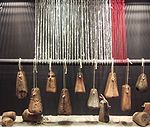
According to textile expert Mechthild Flury-Lemberg of Hamburg, a seam in the cloth corresponds to a fabric found at the fortress of Masada near the Dead Sea, which dated to the 1st century. The weaving pattern, 3:1 twill, is consistent with first-century Syrian design, according to the appraisal of Gilbert Raes of the Ghent Institute of Textile Technology in Belgium. Flury-Lemberg stated, "The linen cloth of the Shroud of Turin does not display any weaving or sewing techniques which would speak against its origin as a high-quality product of the textile workers of the first century."
In 1999, Mark Guscin investigated the relationship between the shroud and the Sudarium of Oviedo, claimed as the cloth that covered the head of Jesus in the Gospel of John[ 20:6–7] when the empty tomb was discovered. The Sudarium is also reported to have type AB blood stains. Guscin concluded that the two cloths covered the same head at two distinct, but close moments of time. Avinoam Danin (see below) concurred with this analysis, adding that the pollen grains in the Sudarium match those of the shroud. Skeptics criticize the polarized image overlay technique of Guscin and suggest that pollen from Jerusalem could have followed any number of paths to find its way to the sudarium.
In 2002, Aldo Guerreschi and Michele Salcito argued that many of these marks on the fabric of the shroud stem from a much earlier time because the symmetries correspond more to the folding that would have been necessary to store the cloth in a clay jar (like cloth samples at Qumran) than to that necessary to store it in the reliquary that housed it in 1532.
Dirt particles
Joseph Kohlbeck from the Hercules Aerospace Company in Utah and Richard Levi-Setti of the Enrico Fermi Institute examined some dirt particles from the Shroud surface. The dirt was found to be travertine aragonite limestone. Using a high-resolution microprobe, Levi-Setti and Kolbeck compared the spectra of samples taken from the Shroud with samples of limestone from ancient Jerusalem tombs. The chemical signatures of the Shroud samples and the tomb limestone were found identical except for minute fragments of cellulose linen fibre that could not be separated from the Shroud samples.
Biological and medical forensics
Blood stains
There are several reddish stains on the shroud suggesting blood, but it is uncertain whether these stains were produced at the same time as the image, or afterwards. McCrone (see painting hypothesis) identified these as containing iron oxide, theorizing that its presence was likely due to simple pigment materials used in medieval times. Other researchers, including Alan Adler, identified the reddish stains as blood and interpreted the iron oxide as a natural residue of hemoglobin.
Heller and Adler further studied the dark red stains and determined and identified hemoglobin, establishing, within claimed scientific certainty, the presence of porphyrin, bilirubin, albumin, and protein. Working independently forensic pathologist Pier Luigi Baima Bollone, concurred with Heller and Adler's findings and identified the blood as AB blood group. Subsequently, STURP sent blood flecks to the laboratory devoted to the study of ancient blood at the State University of New York (SUNY), Binghamton. Dr. Andrew Merriwether at SUNY stated that no blood typing could be confirmed, and the DNA was badly fragmented. He stated that it is almost certain that the blood spots are blood, but no definitive statements can be made about its nature or provenience, i.e., whether it is male and from the Near East."
Joe Nickell argues that results similar to Heller and Adler's could be obtained from tempera paint. Skeptics also cite other forensic blood tests whose results dispute the authenticity of the Shroud that the blood could belong to a person handling the shroud, and that the apparent blood flows on the shroud are unrealistically neat.
Flowers and pollen
In 1997 Avinoam Danin, a botanist at the Hebrew University of Jerusalem, reported that he had identified the type of Chrysanthemum coronarium, Cistus creticus and Zygophyllum whose pressed image on the shroud was first noticed by Alan Whanger in 1985 on the photographs of the shroud taken in 1931. He reported that the outlines of the flowering plants would point to March or April and the environs of Jerusalem. In a separate report in 1978 Danin and Uri Baruch reported on the pollen grains on the cloth samples, stating that they were appropriate to the spring in Israel. Max Frei, a Swiss police criminologist who initially obtained pollen from the shroud during the STURP investigation stated that of the 58 different types of pollens found, 45 were from the Jerusalem area, while 6 were from the eastern Middle East, with one pollen species growing exclusively in Constantinople, and two found in Edessa, Turkey. Mark Antonacci argues that the pollen evidence and flower images are inherently interwoven and strengthen each other.
Skeptics have argued that the flower images are too faint for Danin's determination to be definite, that an independent review of the pollen strands showed that one strand out of the 26 provided contained significantly more pollen than the others, perhaps pointing to deliberate contamination. Skeptics also argue that Max Frei had previously been duped in his examination of the Hitler Diaries and that he may have also been duped in this case, or may have introduced the pollens himself. J. Beaulieau has stated that Frei was a self-taught amateur palynologist, was not properly trained, and that his sample was too small.
In 2008 Avinoam Danin reported analysis based on the ultraviolet photographs of Miller and Pellicori taken in 1978. Danin reported five new species of flower, which also bloom in March and April and stated that a comparison of the 1931 black and white photographs and the 1978 ultraviolet images indicate that the flower images are genuine and not the artifact of a specific method of photography.
Anatomical forensics
A number of studies on the anatomical consistency of the image on the shroud and the nature of the wounds on it have been performed, following the initial study by Yves Delage in 1902. While Delage declared the image anatomically flawless, others have presented arguments to support both authenticity and forgery.
In 1950 physician Pierre Barbet wrote a long study called A Doctor at Calvary which was later published as a book. Barbet stated that his experience as a battlefield surgeon during World War I led him to conclude that the image on the shroud was authentic, anatomically correct and consistent with crucifixion.
In 1997 physician and forensic pathologist Robert Bucklin constructed a scenario of how a systematic autopsy on the man of the shroud would have been conducted. He noted the series of traumatic injuries which extend from the shoulder areas to the lower portion of the back, which he considered consistent with whipping; and marks on the right shoulder blade which he concluded were signs of carrying a heavy object. Bucklin concluded that the image was of a real person, subject to crucifixion.
For over a decade, medical examiner Frederick Zugibe performed a number of studies using himself and volunteers suspended from a cross, and presented his conclusions in a book in 1998. Zugibe considers the shroud image and its proportions as authentic, but disagrees with Barbet and Bucklin on various details such as blood flow. Zugibe concluded that the image on the shroud is of the body of a man, but that the body had been washed.
In 2001, Pierluigi Baima Bollone, a professor of forensic medicine in Turin, stated that the forensic examination of the wounds and bloodstains on the Shroud indicate that the image was that of the dead body of a man who was whipped, wounded around the head by a pointed instrument and nailed at the extremities before dying.
In 2010 Giulio Fanti, professor of mechanical measurements, wrote that "apart from the hands afterward placed on the pubic area, the front and back images are compatible with the Shroud being used to wrap the body of a man 175±2 cm tall, which, due to cadaveric rigidity, remained in the same position it would have assumed during crucifixion".
Artist Isabel Piczek stated in 1995 that while a general research opinion sees a flatly reclining body on the Shroud, the professional figurative artist can see substantial differences from a flatly reclining position. She stated that the professional arts cannot find discrepancies and distortions in the anatomy of the "Shroud Man".
Authors Joe Nickell, in 1983, and Gregory S. Paul in 2010, separately state that the proportions of the image are not realistic. Paul stated that the face and proportions of the shroud image are impossible, that the figure cannot represent that of an actual person and that the posture was inconsistent. They argued that the forehead on the shroud is too small; and that the arms are too long and of different lengths and that the distance from the eyebrows to the top of the head is non-representative. They concluded that the features can be explained if the shroud is a work of a Gothic artist.
Image and text analysis
Image analysis
Both Digital image processing and analog techniques have been applied to the shroud images.
In 1976 Pete Schumacher, John Jackson and Eric Jumper analysed a photograph of the shroud image using a VP8 Image Analyzer, which was developed for NASA to create 3D images of the moon. They found that, unlike any photograph they had analyzed, the shroud image has the property of decoding into a 3-dimensional image, when the darker parts of the image are interpreted to be those features of the man that were closest to the shroud and the lighter areas of the image those features that were farthest. The researchers could not replicate the effect when they attempted to transfer similar images using techniques of block print, engravings, a hot statue, and bas-relief.
NASA researchers Jackson, Jumper, and Stephenson report detecting the impressions of coins placed on both eyes after a digital study in 1978. The two- lepton coin on the right eyelid was presumably coined under Pilate in 29-30, while the one-lepton coin on the left eyebrow was minted in 29. The authenticity of the alleged coins has been disputed and defended.
In 2004, in an article in Journal of Optics A, Fanti and Maggiolo reported finding a faint second face on the backside of the cloth, after the 2002 restoration.
The front image of the Turin Shroud, 1.95 m long, is not directly compatible with the back image, 2.02 m long. In order to verify the possibility that both images were generated by the same human body, a numeric-anthropomorphous manikin was constructed by computer and wrapped in the digitized front and back images. Kinematic analysis showed that the front and back images are compatible with the Shroud being used to wrap the body of a man 175±2 cm tall, which, due to cadaveric rigidity, remained in the same position it would have assumed during crucifixion.
Text of death certificate
In 1979 Greek and Latin letters were reported as written near the face. These were further studied by André Marion, professor at the École supérieure d'optique and his student Anne Laure Courage, in 1997. Subsequently, computerized analysis and microdensitometer, other writings were reported, among them INNECEM (a shortened form of Latin "in necem ibis"—"you will go to death"), NNAZAPE(N)NUS (Nazarene), IHSOY (Jesus) and IC (Iesus Chrestus). The uncertain letters IBE(R?) have been conjectured as " Tiberius". Linguist Mark Guscin disputed the reports of Marion and Courage. He stated that the inscriptions made little grammatical or historical sense and that they did not appear on the slides that Marion and Courage indicated.
In 2009, Barbara Frale, a paleographer in the Vatican Secret Archives, who had published two books on the Shroud of Turin reported further analysis of the text. In her books Frale had stated that the shroud had been kept by the Templars after 1204. In 2009 Frale stated that it is possible to read on the image the burial certificate of Jesus the Nazarene, or Jesus of Nazareth, imprinted in fragments of Greek, Hebrew and Latin writing.
Frale stated the text on the Shroud reads: "In the year 16 of the reign of the Emperor Tiberius Jesus the Nazarene, taken down in the early evening after having been condemned to death by a Roman judge because he was found guilty by a Hebrew authority, is hereby sent for burial with the obligation of being consigned to his family only after one full year." Since Tiberius became emperor after the death of Octavian Augustus in AD 14, the 16th year of his reign would be within the span of the years AD 30 to 31. Frale's methodology has been criticized, partly based on the objection that the writings are too faint to see.
Hypotheses on image origin
Many hypotheses have been formulated and tested to explain the image on the Shroud. According to authors Baldacchini and Fanti to date, despite numerous and often media-related claims, it can be said that "the body image of the Turin Shroud has not yet been explained by traditional science; so a great interest in a possible mechanism of image formation still exists", a conclusion also supported by Philip Ball.
Painting and pigmentation
Painting
The technique used for producing the image is, according to W. McCrone, already described in a book about medieval painting published in 1847 by Charles Lock Eastlake ("Methods and Materials of Painting of the Great Schools and Masters"). Eastlake describes in the chapter "Practice of Painting Generally During the XIVth Century" a special technique of painting on linen using tempera paint, which produces images with unusual transparent features—which McCrone compares to the image on the shroud.
This hypothesis was declared to be unsound as the X-ray fluorescence examination, as well as infrared thermography, did not point out any pigment. It was also found that 25 different solvents, among them water, do not reduce or sponge out the image. The non-paint origin has been further claimed by Fourier transform of the image: common paintings show a directionality that is absent from the Turin Shroud.
Acid pigmentation
In 2009, Luigi Garlaschelli, professor of organic chemistry at the University of Pavia, announced that he had made a full size reproduction of the Shroud of Turin using only medieval technologies. Garlaschelli placed a linen sheet over a volunteer and then rubbed it with an acidic pigment. The shroud was then aged in an oven before being washed to remove the pigment. He then added blood stains, scorches and water stains to replicate the original. But according to Giulio Fanti, professor of mechanical and thermic measurements at the University of Padua, "the technique itself seems unable to produce an image having the most critical Turin Shroud image characteristics".
Medieval photography
According to the art historian Nicholas Allen the image on the shroud was formed by a photographic technique in the 13th century. Allen maintains that techniques already available before the 14th century—e.g., as described in the Book of Optics, which was at just that time translated from Arabic to Latin—were sufficient to produce primitive photographs, and that people familiar with these techniques would have been able to produce an image as found on the shroud. To demonstrate this, he successfully produced photographic images similar to the shroud using only techniques and materials available at the time the shroud was made. He described his results in his PhD thesis, in papers published in several science journals, and in a book.
Lynn Picknett has written a book proposing that Leonardo da Vinci had faked the Shroud. Picknett and Larissa Tracy appeared on a Channel 5 (UK) TV program that claimed the Shroud to be the oldest known surviving photograph. The program claimed that da Vinci used a real corpse, obtained an old-looking piece of linen, treated it with photo-sensitive chemicals and then exposed it in an early form of camera obscura to obtain the image. However John Jackson, director of the Turin Shroud Centre of Colorado dismissed these hypotheses. Jackson et al. have argued that a double photographic exposure, needed in that case, should have considered the distances and in this case there would be areas of photographic superimposition with different lights and shades. The distances on Shroud instead correspond to the body position.
Dust-transfer technique
Scientists Emily Craig and Randall Bresee have attempted to recreate the likenesses of the shroud through the dust-transfer technique, which could have been done by medieval arts. They first did a carbon-dust drawing of a Jesus-like face (using collagen dust) on a newsprint made from wood pulp (which is similar to 13th and 14th century paper). They next placed the drawing on a table and covered it with a piece of linen. They then pressed the linen against the newsprint by firmly rubbing with the flat side of a wooden spoon. By doing this they managed to create a reddish brown image with a lifelike positive likeness of a person, a three dimensional image and no sign of brush strokes. However, according to Fanti and Moroni, this does not reproduce many special features of the Shroud at microscopic level.
Bas-relief
Another hypothesis suggests that the Shroud may have been formed using a bas-relief sculpture. Researcher Jacques di Costanzo, noting that the Shroud image seems to have a three-dimensional quality, suggested that perhaps the image was formed using an actual three-dimensional object, such as a sculpture. While wrapping a cloth around a life-sized statue would result in a distorted image, placing a cloth over a bas-relief would result in an image like the one seen on the shroud. To demonstrate the plausibility of his hypothesis, Costanzo constructed a bas-relief of a Jesus-like face and draped wet linen over the bas-relief. After the linen dried, he dabbed it with a mixture of ferric oxide and gelatine. The result was an image similar to that of the Shroud. The imprinted image turned out to be wash-resistant, impervious to temperatures of 250 °C (482 °F) and was undamaged by exposure to a range of harsh chemicals, including bisulphite which, without the help of the gelatine, would normally have degraded ferric oxide to the compound ferrous oxide. Similar results have been obtained by former stage magician and author Joe Nickell. Instead of painting, the bas-relief could also be heated and used to burn an image into the cloth.
According to Fanti and Moroni, after comparing the histograms of 256 different grey levels, it was found that the image obtained with a bas-relief has grey values included between 60 and 256 levels, but it is much contrasted with wide areas of white saturation (levels included between 245 and 256) and lacks of intermediate grey levels (levels included between 160 and 200). The face image on the Shroud instead has grey tonalities that vary in the same values field (between 60 and 256), but the white saturation is much less marked and the histogram is practically flat in correspondence of the intermediate grey levels (levels included between 160 and 200).
Maillard reaction
The Maillard reaction is a form of non-enzymatic browning involving an amino acid and a reducing sugar. The cellulose fibers of the shroud are coated with a thin carbohydrate layer of starch fractions, various sugars, and other impurities. In a paper entitled "The Shroud of Turin: an amino-carbonyl reaction may explain the image formation," Raymond Rogers and Anna Arnoldi propose that amines from a recently deceased human body may have undergone Maillard reactions with this carbohydrate layer within a reasonable period of time, before liquid decomposition products stained or damaged the cloth. The gases produced by a dead body are extremely reactive chemically and within a few hours, in an environment such as a tomb, a body starts to produce heavier amines in its tissues such as putrescine and cadaverine. However the potential source for amines required for the reaction is a decomposing body, while no signs of decomposition have been found on the Shroud. The image resolution and the uniform coloration of the linen resolution seem to be not compatible with a mechanism involving diffusion.
Alan A. Mills argued that the image was formed by the chemical reaction auto-oxidation. He noted that the image corresponds to what would have been produced by a volatile chemical if the intensity of the colour change were inversely proportional to the distance from the body of a loosely draped cloth.
2010s developments
In 2010, professors of statistics Marco Riani and Anthony C. Atkinson wrote in a scientific paper that the statistical analysis of the raw dates obtained from the three laboratories for the radiocarbon test suggests the presence of contamination in some of the samples. They conclude that: "The effect is not large over the sampled region … our estimate of the change is about two centuries."
A team of graphic artists tried to recreate the real face of the man depicted on the cloth in a special two-hour documentary on the History Channel broadcast for the first time in March 2010. The image was made by taking the image of the Turin Shroud and transforming it onto a 3D form to compose and inspire a CGI image of a detailed face.
The Shroud was placed back on public display (the 18th time in its history) in Turin from 10 April to 23 May 2010. According to Church officials, more than 2 million visitors came to see the Shroud.
In December 2010 Professor Timothy Jull, editor of Radiocarbon, coauthored an article with a textile expert in this peer-reviewed journal. They analyzed an unknown sample of 1988 and concluded that they found no evidence of a repair.
In November 2011, F. Curciarello et al. published a paper that analyzed the abrupt changes in the yellowed fibril density values on the Shroud image. They concluded that the rapid changes in the body image intensity are not anomalies in the manufacturing process of the linen but that they can be explained with the presence of aromas and/or burial ointments. The paper also states that this consistent with the observation that based on the stochastic distribution of yellowed fibrils the image is not the work of an artist, and may have been formed over several decades. However, their work leaves the existence of an energy source for the image an open question.
In December 2011 scientists at Italy's National Agency for New Technologies, Energy and Sustainable Development ENEA announced that their series of tests demonstrated the image on the shroud could, in their opinion, only have been created by "some form of electromagnetic energy" such as a flash of light at short wavelength. Professor Paolo Di Lazzaro, the lead researcher, indicated in an e-mail interview that '….it appears unlikely a forger may have done this image with technologies available in the Middle Ages or earlier', but their study does not mean the Shroud image was created by the flash of a miraculous resurrection, contrary to how the story was presented in the media, especially on the Web. Prominent skeptic Joe Nickell, however, is not impressed with the news. He indicates the latest findings is nothing new despite being 'dressed up in high-tech tests' and doesn't prove much of anything.
In December 2011 physicist Giulio Fanti published a critical compendium of the major hypotheses regarding the formation of the body image on the shroud. Fanti stated that "none of them can completely explain the mysterious image". Fanti then considered corona discharge as the most probable hypothesis regarding the formation of the body image.
In his 2012 book The Sign, art historian Thomas de Wesselow (who has stated that religiously he remains an agnostic and does not believe in the resurrection of Jesus) has written that he has come to view the shroud as genuine. In the book he argues that the Shroud caused the disciples to believe that Jesus had resurrected, but he does not support the historicity of the resurrection itself. According to The Daily Telegraph, de Wesselow has mostly assembled and reinterpreted the work of other researchers, rather than doing firsthand research himself.
